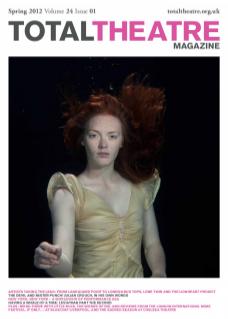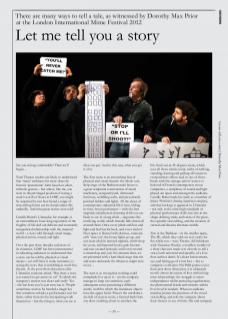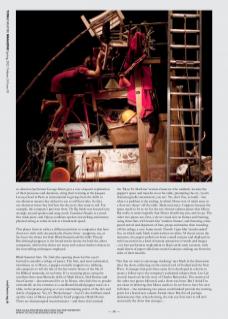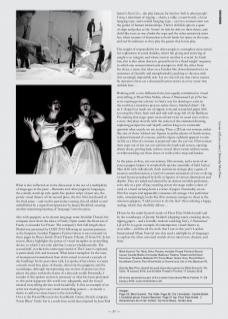Are you sitting comfortably? Then we’ll begin…
Total Theatre readers are likely to understand that ‘mime’ embraces far more than the historic ‘pantomime’ form based on silent, mimetic gesture – but unless, like me, you were in the privileged position of seeing a week’s worth of shows at LIMF, you might be surprised by just how broad a range of storytelling forms can be found under this umbrella. And what great stories were told!
Camille Boitel’s L’Immediat, for example, is an extraordinary hour-long exposition of the fragility of life and our delicate and constantly renegotiated relationship with the material world – a story told through visual image, physical action, sound, and light.
Over the past three decades and more of its existence, LIMF has been instrumental in educating audiences to understand that a story can be told by physical or visual means – yet still there is some resistance to seeing the story that is unfolding in word-free theatre. At the post-show discussion after L’Immediat, someone asked, ‘Was there a story you wanted to get across to us?’ To which the company’s answer was short and swift: ‘Yes – the last hour you’ve just seen was it.’ People sometimes want to be handed a magic key that somehow unlocks a performance text for them, rather than do the interpreting work themselves – but the thing is, what you see is what you get. And in this case, what you get is a lot.
The first scene is an astonishing feat of physical and visual theatre: the whole vast, deep stage of the Barbican main house is a great sculptural construction of metal machinery, scrapyard junk, distressed furniture, wobbling walls, and precariously perched ladders and lights. All the chaos of contemporary industrial life is here, biding its time. Seven performers – with the best slapstick and physical clowning skills you are likely to see in a long while – negotiate this terrifying world, which literally falls down all around them. Once every plank and box and light and bed has hit back, and every inch of floor space is littered with detritus, someone calls ‘time out’, the house lights go up, and our team (clad in tattered nighties, thrift-shop fur coats, and battered boots) grab brooms and race around furiously until every morsel is cleared up and, just five minutes later, we are presented with a bare black stage that sits and waits ominously for whatever might next occur…
The start is so strong that nothing could completely live up to it – yet the company manage to keep our attention, each subsequent scene presenting a different wonky world in which the inanimate objects have the upper hand. There’s the wardrobes-are-full-of-secrets scene, a farcical dash from one door-crashing closet to another; the life-lived-out-at-45-degrees scene, which uses all those classic mime tricks of walking, standing, leaning and pulling off-centre to extraordinary effect; and, in one of those ‘break with the onstage action’ scenes so beloved of French contemporary circus companies, a symphony of sound and light played out upon and amongst the audience. Camille Boitel made his mark as a member of James Thiérrée’s Junebug Symphony company, and that heritage is apparent in L’Immediat – not only in the ultra-high standards of physical performance skills, but also in the shape-shifting tricks and turns of the piece, the episodic storytelling, and the creation of surreal and dreamy alternate worlds.
Also at the Barbican – in the smaller space, The Pit, which they sold out very easily for the whole run – were Theatre Ad Infinitum with Translunar Paradise, a wordless wonder of a show that uses mask very cleverly to tell a story, both universal and specific, of a love that outlives death. It’s about bereavement, yes, and letting go of a lost love – but as company co-director Nir Paldi points out in their post-show discussion, it is ultimately mostly about the nature of love within longterm relationships: the struggle to assert independence whilst nurturing togetherness; the phenomenal bonds and tensions within lives lived in tandem. When an audience member praises the precision of the visual storytelling, and asks the company about their choices in use of form, Nir and company co-director/performer George Mann give a very eloquent explanation of their processes and decisions, citing their training at the Jacques Lecoq school in Paris as instrumental in giving them the skills to use whatever means they wished to use to tell their tales. So they use whatever form they feel best fits the story they want to tell. For example, the company’s previous show The Big Smoke was focused very strongly around spoken and sung word; Translunar Paradise is a word-free mask piece; and Odyssey combines spoken storytelling and intense physical acting to relate its tale at a breakneck speed.
This places them in rather a different position to companies that have chosen to stick with one particular theatre form – puppetry, say, as has been the choice for both Blind Summit and Invisible Thread. But although puppetry is the broad-stroke choice for both the above companies, within that choice are many and various further choices in the storytelling techniques employed.
Blind Summit first: The Table (the opening show for this year’s festival) is actually a trilogy of pieces. The first, and most substantial, introduces us to Moses, a puppet eternally trapped on a tabletop, who purports to tell the tale of the last twelve hours of the life of his Biblical namesake, in real time. It’s a stunning piece, using the excellent three-man Bunraku skills of Mark Down, Nick Barnes and Sean Garratt – deconstructed for us by Moses, who feels free to ponder existentially on his existence as a cardboard-headed puppet stuck on a table, in the process giving us a very entertaining précis of the do’s and don’ts of puppetry. Yes, it’s ‘Beckettesque’ – but it’s also brilliant standup (the voice of Moses provided by ‘head’ puppeteer Mark Down). There are dramaturgical inconsistencies – and these don’t include the ‘Deus Ex Machina’ woman character who suddenly invades the puppet’s space and muscles in on his table, prompting the cry, ‘you’re dramaturgically inconsistent, you are’. No, she’s fine, actually – but what is a problem is the ending, in which Moses sort of melts away in a slow-mo ‘dance’ off the table. Made necessary, I suppose because the space needs to be re-set for the two shorter cabaret pieces that follow. But really, it seems logically that Moses should stay put, and we go. The other two pieces are, first, a clever visual skit on frames and framing, using three flats with booth-like ‘window frames’, and featuring a fastpaced arrival and departure of hats, props and masks; then rounding off the trilogy, a very funny mock Nouvelle Vague film ‘storyboarded’ live, in which stark black words written on white A4 sheets create the narrative, the papers pulled out from a small suitcase and displayed in swift succession in a kind of instant animation of words and images – our four performers resplendent in black turtle-neck sweaters, with small sheets of paper rolled into mock Gauloises sticking out from the sides of their mouths.
‘Not that we want to encourage smoking,’ says Mark in the discussion after the show, reflecting on the eternal cool of Godard and the New Wave. It emerges that part three came first: developed in a desire to create a follow-up to the company’s acclaimed cabaret-show Low Life (loosely based on the life story of Charles Bukowski). The creation of the other two pieces followed, and a show was born. But I think I’m not alone in believing that Moses needs to be set free to have his own full show – the remaining two pieces could indeed provide the starting point for a brand-new cabaret-format show. But this all perhaps demonstrates that, when devising, the tale you first start to tell isn’t necessarily the show that emerges…
What is also reflected on in the discussion is the use of a multiplicity of languages in the piece – Bunraku and other puppetry languages, the comedy stand-up style quick-fire spoken script of part one, the purely visual theatre of the second piece, the live film-storyboard of the final piece – and on this particular evening, this all added to and embellished by a signed interpretation by Jacqui Beckford, creating another interesting layering of ‘language’ onto the piece.
Also with puppetry as its chosen language came Invisible Thread, the company risen from the ashes of Faulty Optic under the direction of Faulty co-founder Liz Fraser. The company’s first full-length show Plucked was presented by LIMF 2012 following an autumn premiere at the Suspense London Puppetry Festival where it was reviewed on these pages by Beccy Smith (Total Theatre Volume 23 Issue 04). In her review, Beccy highlights the power of visual metaphor as storytelling device, to which I can only add that I concur wholeheartedly. The second half, in which the archetypal world of The Crone is explored, is particularly rich and resonant. What better metaphor for the state of menopausal womanhood than skirts raised to reveal a cascade of dry kindling? In the post-show talk, Liz spoke of her choice to create a mostly word-free piece of theatre, driven by the puppetry and the soundscape, although incorporating one section of poetic text that places the piece within the frame of a fairytale world. Personally, I wonder if this spoken section is necessary as what has been presented to this point signposts this world very adequately, and the visual/ musical storytelling devices work beautifully. Is this an example of an artist not trusting her own visual storytelling powers – or merely a desire to add ever-more layers to the storytelling?
Over at the Purcell Room at the Southbank Centre, French company Toron Blues’ Tendre Suie is a corde lisse aerial duet inspired by Jean Paul Sartre’s Huis Clos – the play famous for the line ‘hell is other people’. Using a minimum of staging – chairs, a table, a water bottle, a loose hanging rope, and a coiled hanging rope – our two-woman team run the gamut of human relationships. There’s childish spite in a spate of slaps and pokes as the ‘sisters’ sit side-by-side on their chairs, and child-like trust as one climbs the rope and the other tentatively joins her; silent screams of frustration as both battle for space on the rope, and red-lit embraces as they play the games that lovers play.
The weight of responsibility for other people is a metaphor most suited for exploration in aerial doubles, where the giving and receiving of weight is so integral, and where trust in another is crucial. In Tendre Suie, this is also taken down to ground level in a ‘dead weight’ sequence in which one woman laboriously attempts to shift the other from her chair, a scene that takes on a Gaulier-like clown dimension in its insistence of (literally and metaphorically) pushing to the max with this seemingly impossible task. Let no-one tell you that circus cannot be narrative: there are a thousand human stories in every scene that unfolds here…
Working with a very different form, but equally committed to visual storytelling, is Fleur Elise Noble, whose 2 Dimensional Life of Her has as its starting point a desire ‘to find a way for drawing to exist in the world as a transitory process rather than a finished object’. On an L-shaped set made out of ripped, torn and scrunched paper (this set using the floor, back wall and side wall stage-left of the Barbican Pit, making that stage space seem at least twice its usual size) evolves a story that plays cleverly with the notion of the animated drawing, exploring perspective and ‘depth’, and inviting us to constantly question what exactly we are seeing. Thus, a 2D cut-out woman, rather like one of those ‘whited-out’ figures in police photos of bomb scenes, is placed forward of a screen, and the figure suddenly appears to take on life as a film of a woman is projected onto the cut-out. Film-woman then steps out of her cut-out and into the back-wall screen, opening drawn doors, peeling back walls to reveal other rooms within rooms, or whitewashing out those doors or walls with a mop and bucket.
As the piece evolves, cut-out woman, film woman, and a team of onscreen puppet helpers (a wonderfully spooky ensemble of bald Action Man dolls with ridiculously thick marionette strings) play a game of creation and destruction, a kind of constant animation of ever-evolving virtual houses populated by dolls or figures of various dimensions and depths. They are aided and abetted by an almost-invisible performer, seen only as a pair of legs scuttling across the stage under a sheet of card, or a hand turning down a corner of paper. Eventually, an onfilm fire erupts and apparently consumes all onstage. Our performer (who, unsurprisingly, looks like film-woman) emerges to shout at the onscreen puppets, ‘I told you not to do the fire!’ then ordering a happy ending, which they dutifully deliver…
Driven by the multi-layered visuals of Fleur Elise Noble herself and by the soundscape of Jeremy Neideck (slopping water, creaking doors, ripping paper – and a horribly realistic crackling fire!), 2 Dimensional Life of Her is a great example of contemporary visual theatre as storyteller – and like all the work that I saw at this year’s London International Mime Festival one that used a multiplicity of languages to explore the often unvoiced worlds of our inner lives, dreams, and fears.
Blind Summit The Table, Soho Theatre; Invisible Thread Plucked, Roundhouse; Camille Boitel L’Immediat, Barbican Theatre; Theatre Ad Infinitum Translunar Paradise, Barbican Pit; Toron Blues Tendre Suie, Purcell Room Southbank Centre; Fleur Elise Noble 2 Dimensional Life of Her, Barbican Pit.
Dorothy Max Prior chaired the post-show discussions for Blind Summit’s The Table, 16 January 2012; and Invisible Thread’s Plucked, 17 January 2012.
All shows presented as part of the London International Mime Festival 11–29 January 2012. www.mimelondon.com



